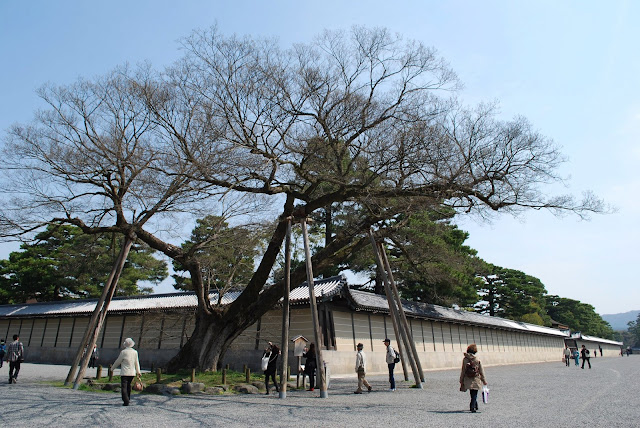A small part of the high walls around the Kyoto Imperial Palace situated within the large palace enclosure. This venerable, 300-year old tree is known as the 'Muku of the Shimizudani residence' after the house of a court noble who lived nearby in the ancient times. Alive and well, it still needs some help from sturdy wooden poles - so typical for Japanese gardens.
Here's another unscripted visit... one of our mornings in Kyoto with no fixed plans for the day, I noticed that Kyōto Gosho, the Imperial Palace of Kyoto, would be opening for its annual five spring days, so we decided to take a stroll there from our hotel close by to see if the crowds would be reasonable enough to allow for a visit. Of course, the two lines were long well before the opening time, but we stayed, curious about the contents within the high walls.
Sharply at 9 am, the palace gates were opened and the (mostly Japanese) crowds welled into the grounds, well-behaved as always - no pushing or skipping queues here. Also, the crowds were remarkably silent, whispering to each other only in gentle voices, which I took as a sign of their reverence to the emperor. Of course, I'm not sure if I read this correctly, or if it just was just another sign of the constant politeness of the Japanese (rather pleasantly, they don't even speak to their mobile phones when using public transport - can you imagine that in any other country?).
The palace and gardens are surrounded by high walls with four large gates, and to reach them you have to walk through the old palace enclosure within its easily recognizable, beautiful stone walls. Earlier, several residences of high court nobles were situated within this area, but were demolished and replaced with a park when the court moved to Tokyo; Shu Sui Tei teahouse, that I wrote for about a week ago is one of the few remains of the luxurious residences within the enclosure.
The Imperial Palace in Kyoto was the seat of the Emperor from the Heian period (794-1185) until the end of the Edo period (1603-1868). In 1869, the Emperor moved with his court to the Old Edo, which became the official capital of Japan and changed its name to Tokyo, which means 'Capital of the East'. Despite this, Kyōto-gosho has still had an important role as a ceremonial site, and both Taisho and Showa emperors had their coronation ceremonies here.
Despite the palace grounds and buildings being handsomely impressive and the gardens extremely well-tended - as could be expected - I wouldn't necessarily recommend someone to make an extra effort to see them. The palace and even the gardens do feel a bit too official and a bit 'dead', which is understandable as they today only serve for ceremonial purposes. With most of us having a limited amount of time in Kyoto, there are so many more interesting, beautiful and/or charming places to see and experience. For us, the charm was mostly in the unexpected, and we left contented, enjoying afterwards a green tea with some bean paste cakes in the outer gardens where tents had been set up to serve the crowds with traditional Japanese spring time delicacies.
The whole palace enclosure was carefully prepared for its five day spring opening - the crowds didn't disappoint and turned up in the thousands... One of the large, wooden gates leading to the palace and gardens inside the high walls.
More gates within the gates... the inner, vermilion painted Jomeimon gates lead to the large,
ceremonial inner courtyard in front of the Shishin-den main hall; the coronation ceremonies take place here.
ceremonial inner courtyard in front of the Shishin-den main hall; the coronation ceremonies take place here.
The Jomeimon gate from inside; the white gravel of the large inner courtyard has been meticulously raked...
The hipped gables of the Shishin-den main hall. Sacred trees stand on each side of its main stairway, a Sakonno sakura (cherry) on the eastern, and above, a Ukonno tachibana (a wild native citrus tree) on the western side.
The Oikeniwa garden outside the ceremonial halls has a large pond, with several stone bridges arching over the water.
Seiryō-den, where the Emperors would be conducting their personal affairs... I wonder what that could have been, in their highly ceremonial and official lives? A rare bamboo towers in front of the building, caged in a wooden crate.
Large paintings with scenes from the imperial lives fill the walls inside the imperial palace.

The thatched gables of the Otsunegoten imperial villa on the palace grounds.
Wooden bridge in the inner, Gonaitei garden, strictly reserved for the Emperor's private use.
One of the many stone paths in the Gonaitei-garden.
Another small bridge, and mossy stones from the Gonaitei-garden...
A pebbled water stream, and a pine tree with a tutu - Japanese structures for supporting trees and plants are just the most beautiful in the world!
Extremely unnatural nature - all plants were carefully pruned into the ideally suited form for the garden - very Japanese and very beautiful (and I know that some of you completely disagree with the practice...).
The Kyoto Imperial Palace is open for public 5 days each spring and autumn; otherwise, visits are available only by booking a tour through the Imperial Household Agency (at 10am and 2pm daily).
























































